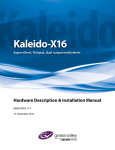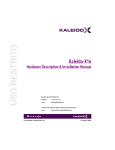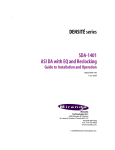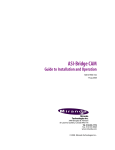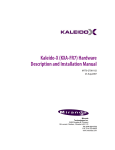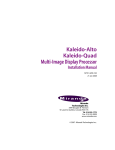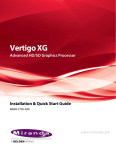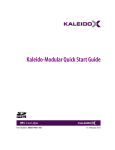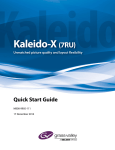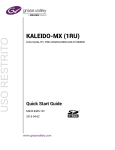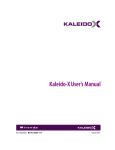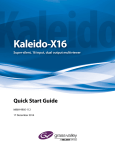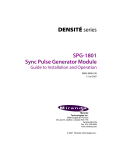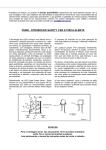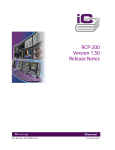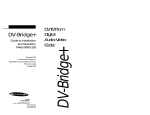Download Kaleido-X16 Installation Manual
Transcript
Kaleido-X16 Hardware Description & Installation Manual Part Number: M869-9902-107 27 May 2011 0 Copyright © 2009–2011, Miranda Technologies Inc. All rights reserved. ATTENTION: please read the following terms and conditions carefully. By using Kaleido-X16 documentation, you agree to the following terms and conditions: Miranda Technologies Inc. hereby grants permission and license to owners of Kaleido-X16 to use their product manuals for their own internal business use. Manuals for Miranda Technologies Inc. products may not be reproduced or transmitted in any form or by any means, electronic or mechanical, including photocopying and recording, for any purpose unless specifically authorized in writing by Miranda Technologies Inc. A Miranda Technologies Inc. manual may have been revised to reflect changes made to the product during its manufacturing life. Thus, different versions of a manual may exist for any given product. Care should be taken to ensure that one obtains the proper manual version for a specific product serial number. Information in this document is subject to change without notice and does not represent a commitment on the part of Miranda Technologies Inc. ii Title Kaleido-X16 Hardware Description & Installation Manual Part Number M869-9902-107 Revision 27 May 2011, 7:30 pm Kaleido-X16 Hardware Description & Installation Manual Safety Compliance This equipment complies with the requirements of the following standards for safety of information technology equipment: • CSA-C22.2 No. 60950-1-07 • UL 60950-1 (2nd Edition) • EN 60950-1:2006 ITE • IEC 60950-1:2005 (2nd Edition) WARNING: An appropriately listed/certified mains supply power cord must be used for the connection of the equipment to the mains voltage at either 120V~ or 240V~. CAUTION: These servicing instructions are for use by qualified service personnel only. To reduce the risk of electric shock, do not perform any servicing other than that contained in the operating instructions unless you are qualified to do so. Refer all servicing to qualified service personnel. Servicing should be done in a static-free environment. Electromagnetic Compatibility This equipment has been tested for verification of compliance with FCC Part 15, Subpart B requirements for class A digital devices. Note: This equipment has been tested and found to comply with the limits for a Class A digital device, pursuant to Part 15 of the FCC rules. These limits are designed to provide reasonable protection against harmful interference when the equipment is operated in a commercial environment. This equipment generates, uses, and can radiate radio frequency energy, and, if not installed and used in accordance with the instruction manual, may cause harmful interference to radio communications. Operation of this equipment in a residential area is likely to cause harmful interference in which case the user will be required to correct the interference at his own expense. This equipment has been tested and complies with the requirements of the directive 2004/108/CE: • EN 55022 Class A Radiated and conducted emissions • EN 61000-3-2 Limits for harmonic current emissions • EN 61000-3-3 Limitation of voltage changes, voltage fluctuations and flicker • EN 61000-4-2 Electrostatic discharge immunity iii • EN 61000-4-3 Radiated, radio-frequency, electromagnetic field immunity • EN 61000-4-5 Surge transient immunity • EN 61000-4-6 Conducted disturbances immunity • EN 61000-4-11 Voltage dips, short interruptions and voltage variations immunity Warranty Policies Warranty information is available in the Support section of the Miranda Web site (www.miranda.com). Table of Contents 1 Kaleido-X16 Installation 1 Introduction . . . . . . . . . . . . . . . . . . . . . . . . . . . . . . . . . . . . . . . . . . . . . . . . . . . . . . . . . . . . . . . . . . . . . . . . . . . . . . . . . . . . . . . . . . . . . . . . . . . 1 Mechanical Installation . . . . . . . . . . . . . . . . . . . . . . . . . . . . . . . . . . . . . . . . . . . . . . . . . . . . . . . . . . . . . . . . . . . . . . . . . . . . . . . . . . . . . . . . . . 5 Frame and Electrical Installation . . . . . . . . . . . . . . . . . . . . . . . . . . . . . . . . . . . . . . . . . . . . . . . . . . . . . . . . . . . . . . . . . . . . . . . . . . . . . . . . . . 6 CompactFlash . . . . . . . . . . . . . . . . . . . . . . . . . . . . . . . . . . . . . . . . . . . . . . . . . . . . . . . . . . . . . . . . . . . . . . . . . . . . . . . . . . . . . . . . . . . . . . . . . 12 Signalling . . . . . . . . . . . . . . . . . . . . . . . . . . . . . . . . . . . . . . . . . . . . . . . . . . . . . . . . . . . . . . . . . . . . . . . . . . . . . . . . . . . . . . . . . . . . . . . . . . . . 12 Maintenance . . . . . . . . . . . . . . . . . . . . . . . . . . . . . . . . . . . . . . . . . . . . . . . . . . . . . . . . . . . . . . . . . . . . . . . . . . . . . . . . . . . . . . . . . . . . . . . . . . 25 2 Specifications 27 Inputs . . . . . . . . . . . . . . . . . . . . . . . . . . . . . . . . . . . . . . . . . . . . . . . . . . . . . . . . . . . . . . . . . . . . . . . . . . . . . . . . . . . . . . . . . . . . . . . . . . . . . . . 27 Outputs . . . . . . . . . . . . . . . . . . . . . . . . . . . . . . . . . . . . . . . . . . . . . . . . . . . . . . . . . . . . . . . . . . . . . . . . . . . . . . . . . . . . . . . . . . . . . . . . . . . . . . 30 Audio I/O . . . . . . . . . . . . . . . . . . . . . . . . . . . . . . . . . . . . . . . . . . . . . . . . . . . . . . . . . . . . . . . . . . . . . . . . . . . . . . . . . . . . . . . . . . . . . . . . . . . . . 34 Control . . . . . . . . . . . . . . . . . . . . . . . . . . . . . . . . . . . . . . . . . . . . . . . . . . . . . . . . . . . . . . . . . . . . . . . . . . . . . . . . . . . . . . . . . . . . . . . . . . . . . . . 36 Frame . . . . . . . . . . . . . . . . . . . . . . . . . . . . . . . . . . . . . . . . . . . . . . . . . . . . . . . . . . . . . . . . . . . . . . . . . . . . . . . . . . . . . . . . . . . . . . . . . . . . . . . 37 Contact Us! 39 v toc vi Kaleido-X16 Installation The Kaleido-X16 is a 1RU, multi-image display processor with high image quality and a rich feature set. This chapter contains physical descriptions, installation instructions and connection information for the Kaleido-X16 frame. Summary Introduction . . . . . . . . . . . . . . . . . . . . . . . . . . . . . . . . . . . . . . . . . . . . . . . . . . . . . . . . . . . . . . . . . . . . . . . . . . 1 Mechanical Installation . . . . . . . . . . . . . . . . . . . . . . . . . . . . . . . . . . . . . . . . . . . . . . . . . . . . . . . . . . . . . . . . . 5 Frame and Electrical Installation . . . . . . . . . . . . . . . . . . . . . . . . . . . . . . . . . . . . . . . . . . . . . . . . . . . . . . . . . 6 CompactFlash . . . . . . . . . . . . . . . . . . . . . . . . . . . . . . . . . . . . . . . . . . . . . . . . . . . . . . . . . . . . . . . . . . . . . . . . 12 Signalling . . . . . . . . . . . . . . . . . . . . . . . . . . . . . . . . . . . . . . . . . . . . . . . . . . . . . . . . . . . . . . . . . . . . . . . . . . . 12 Maintenance . . . . . . . . . . . . . . . . . . . . . . . . . . . . . . . . . . . . . . . . . . . . . . . . . . . . . . . . . . . . . . . . . . . . . . . . . 25 Introduction The Kaleido-X16 system is a cost-effective multi-image processor. It can accommodate smaller systems or scale up to production systems, where smaller building blocks with fewer input counts per display are desirable. Each chassis can display up to 16 auto-sensing HD, SD, or Analog inputs that can be displayed across two high resolution outputs at multiple sizes. 1 Kaleido-X16 Installation Features Features Small form factor 1RU Expandable Expandable multi-room architecture, based on a chassis with 16 inputs, and 2 independent multi-image display outputs Unmatched flexibility Any source can be repeated to any position, to any display, at any size, at any resolution, without blocking or grouping restrictions Kaleido-X16 as a router The Kaleido-X16 can behave as a router, with 16 input channels as sources and the two RT OUT outputs as destinations Superior display Highest quality multi-image output without compression, with superior on-screen graphics, for the most critical live monitoring applications 128 audio channels Unprecedented audio performance with the ability to monitor up to 128 channels of audio, including embedded, discrete analog, discrete AES from ABT DVI inputs DVI inputs (one per output head) mappable in the background of each output without the need for scaling Two-room layouts Intuitive layout editor software allows rapid creation of two-room layouts, which can be recalled quickly from networked remote control panels Highly robust Highly robust design, with multiple points of redundancy, and no single point of failure for reliable 24/7 operation Port Availability The Kaleido-X16 offers a wide variety of ports for incoming and outgoing signals. However, with a view towards future expansion, there are ports whose connections exist but that are currently not fully 2 Kaleido-X16 Hardware Description & Installation Manual supported. The following ports on the Kaleido-X16 are not supported in the current release of the KaleidoX Software: • OPTION streaming output connector • PC In analog audio input ports at the AUDIO I/O connector Overview of the Kaleido-X16 System The following diagram shows a basic Kaleido-X16 system configuration, with a single Kaleido-X16 feeding 2 monitor wall displays. The Kaleido-RCP2 would be located on the production desk, while the Client PC could be anywhere with Internet access to the network. The diagram below shows a Kaleido-X16 system with its inputs and outputs. Examples of the various external devices that connect to the Kaleido-X16 are also shown. The Kaleido-X16 system is available in two model types: a single-head model (Kaleido-X16-S) and a dualhead model (Kaleido-X16-D). Throughout this manual, Kaleido-X16 refers to both models unless it is necessary to distinguish the single-head model from the dual-head model. Kaleido-X16-D There are two heads (Head 1 and Head 2) on the dual-head Kaleido-X16 (Kaleido-X16-D). The Input and Output connections are as follows. 3 1 Kaleido-X16 Installation Kaleido-X16-S Connector Number of connectors on Head 1 Number of connectors on Head 2 MV OUT 1 1 SDI OUT 1 1 DVI IN 1 1 The rear connector panel for this model is displayed, below: In addition to the difference in the number of output heads, the Audio I/O TBA pinout is different between the two models (see “Audio I/O TBA” on page 16 for details). Kaleido-X16-S There is one head (Head 1) on the single-head Kaleido-X16 (Kaleido-X16-S). The Input and Output connections are as follows. Connector Number of connectors on Head 1 MV OUT 1 SDI OUT 1 DVI IN 1 The rear connector panel for this model is displayed, below: No Head 2 connectors (DVI IN2, SDI OUT2, MV OUT2) In addition to the difference in the number of heads, the Audio I/O TBA pinout is different between the two models (see “Audio I/O TBA” on page 16 for details). 4 Kaleido-X16 Hardware Description & Installation Manual Mechanical Installation Unpacking Make sure the following items have been shipped with your Kaleido-X16. If any of these are missing, contact your distributor or Miranda Technologies Inc. • Kaleido-X16 unit with one or two power supplies pre-installed (second power supply optional) • Two support brackets • One AC power cord per power supply • DVD including manuals, software and release notes • One mouse • Four serial port adapters (one with straight wiring and one with crossover wiring for each of the two RS-422 ports on your multi-viewer): Part number Adapter cabling RS-422 pinout at the DE-9P connector 1737-3000-102 Straight Controller (SMPTE master) mode 1792-3700-100 Crossover Tributary (SMPTE slave) mode Notes • The Kaleido-RCP2 unit is optional and is not included in the standard Kaleido-X16 package. Refer to the Kaleido-RCP2 Guide to Installation and Operation (available on the DVD that shipped with your system) for more information. • The standard Kaleido-X16 comes with one PSU. A redundant, second PSU is optional. Mounting the Kaleido-X16 in a Rack To mount the Kaleido-X16 in a standard 19-inch rack: 1. Install both support brackets at the back of the rack by using suitable screws and washers (not included), so that the bottom of the Kaleido-X16 frame will be supported by the brackets. 2. Insert the Kaleido-X16 frame at the designated location within the rack, and secure the front of the frame to the rack by using suitable screws and washers (not included). 5 1 Kaleido-X16 Installation Frame and Electrical Installation IMPORTANT: Mobile Installation If you are deploying your Kaleido-X16 in a mobile unit, it is your responsibility to make sure the back of the multi-viewer is securely attached to the rack. For instance you may install a blank panel at the back of the rack, so that it meets the top of the frame, to prevent the frame from bouncing away from the support brackets. Ventilation For proper ventilation, make sure the front and side panel air vents are not blocked and the air filter is clean. Note: The optional Kaleido-RCP2 may also be installed in a rack, by using the KRCP-RK2 mounting kit. Frame and Electrical Installation The Kaleido-X16 multi-viewer is a self-contained unit consisting of a frame, redundant power supplies, and various input and output cards. The monitor wall displays and external control devices complete the system. Frame The Kaleido-X16 frame is 1 RU high. Input and output connectors are mounted on a connector panel on the rear of the frame. The redundant power supply is installed in the front of the frame. The front cover can be removed to give access to the PSUs, CompactFlash card, USB connector, and basic LEDs. The Kaleido-X16 frame incorporates the following key elements: • A rack-mountable mechanical framework (for mounting into a 19-inch EIA rack) • A removable door to cover and protect the front of the frame • An optional redundant power supply • Ventilation Front view of the Kaleido-X16 frame (PSUs installed; front cover removed) 6 Kaleido-X16 Hardware Description & Installation Manual CPU General Status SDTI Severity DVI Inputs Video Inputs CPF Activity Reference Input LTC LEDs on the front of the frame (behind the cover) The LEDs on the front of the frame (behind the cover) indicate the following conditions depending on their color and whether they are blinking or not: LED LED Status Green Blinking green Red Blinking red Yellow Blinking yellow Off CPU Normal op- Application eration booting Error Live Update OS Booting N/A Front cover is closed CPF Activity N/A Activity N/A N/A N/A N/A No Activity Video Inputs Inputs are locked N/A Inputs are unlocked, or no input ERROR ON SIGNAL N/A N/A Front cover is closed DVI Inputs Inputs are locked N/A Inputs are unlocked, or no input ERROR ON SIGNAL N/A N/A Front cover is closed LTC LTC valid N/A No signal N/A N/A N/A Front cover is closed Ref. Input Input is locked N/A Input is unlocked, or no input ERROR ON SIGNAL N/A N/A Front cover is closed SDTI Inputs are locked N/A Inputs are unlocked, or no input, or no SDTI signal ERROR ON SIGNAL N/A N/A Front cover is closed 7 1 Kaleido-X16 Installation Monitoring the Temperature of the Kaleido-X16 LED LED Status Green Blinking green Gen. Status System OK Severity Boot OK Red Blinking red Yellow Intrusive self- Configuration Failed, diagnostic Safe Mode finished Firmware Upgrading Boot up Diag- Firmware error nostic (Verbose switch on) Booting N/A Fatal error, CALL TECH SUPPORT Boot error, Need liveupdate Blinking yellow N/A Off Front cover is closed No power Monitoring the Temperature of the Kaleido-X16 For optimal performance, it is strongly recommended that you operate the Kaleido-X16 multi-viewer in an environment with an ambient temperature between 0 °C and 40 °C. IMPORTANT: When measuring the ambient room temperature, take your readings from directly in front of the Kaleido-X16 frame. There are two factors that could influence airflow inside the frame: altitude and airflow obstruction on the sides of the unit. Power Supplies Power supply for the Kaleido-X16 frame The Kaleido-X16 frame is powered by dual redundant, current-sharing power supply units (PSUs). The PSUs are installed and removed from the front of the frame and are hot-swappable, so that a defective supply may be replaced without removing the Kaleido-X16 frame from service. When facing the front of the frame, the PSU on the left side is referred to as PSU A and the PSU on the right side is PSU B. 8 Kaleido-X16 Hardware Description & Installation Manual IMPORTANT: If your frame has only one PSU, it must be installed in Slot A (left side of frame) There are two power supplies: an operational PSU and a redundant PSU. The system operates with a single PSU. If you choose to have only one PSU installed in your Kaleido-X16 frame, you should do the following: • Clear the PSU B Installed check box for this Kaleido-X16 frame in XAdmin (see the “Configuring Power Supply Redundancy on the Kaleido-X16” section in the “Getting Started” chapter of the Kaleido-X User’s Manual). • Install the single PSU (PSU A) in Slot A (the left side of the frame when facing the front of the frame) (see “Installing a Power Supply” on page 10). Access the power supplies by removing the front cover of the frame. Viewed from the front of the frame, the PSUs are located on the left-hand and right-hand sides of the frame: PSU A removed from Slot A Slot A Slot B PSU slot locations Two PSUs installed in a frame; front cover removed Removing a Power Supply To remove a power supply: 1. Open the front cover of the frame and locate the power supply (PSU) you would like to remove (either the left or the right side). 2. Pull on the handle on the right side of the PSU and pull the PSU out of the frame. 9 1 Kaleido-X16 Installation Installing a Power Supply Installing a Power Supply To install a power supply: 1. Position the power supply (PSU) in front of an empty power supply slot in front of the frame, with the connector end towards the frame and the PSU handle on the right side. 2. Slide the PSU into the empty slot, moving it gently until it contacts the sockets at the rear of the slot. 3. Push firmly but gently on the PSU faceplate until the PSU’s connectors have mated with the frame's sockets, and the PSU will go in no further. Powering up the Kaleido-X16 Separate AC power sockets serve the two power supplies. On the rear of the frame, connect both power sockets of the Kaleido-X16 to an appropriate power source using the supplied power cords. As seen from the rear of the frame: • The left power socket is for PSU B. • The right power socket is for PSU A. Power socket for PSU B IMPORTANT: Power socket for PSU A • A Kaleido-X16 multi-viewer can draw 4.0 amps of current. Ensure that the circuit to which the frame is connected can handle that load, and that of any other connected devices. • If you only have one PSU, make sure you plug your power cable into the power connector on the right side of the rear connector panel (as you face the rear of the frame). This should be on the same side of the frame as the one PSU you have installed. If you do not do this, your system cannot draw power. • If you have two PSUs, make sure you plug in both power cables into both power connectors of the rear connector panel. If you do not do this your system cannot have PSU redundancy. To power up the Kaleido-X16: 1. Plug the power cord(s) from the Kaleido-X16 into a grounded power outlet. 2. Push the power button at the front of the frame (behind the front cover). Power button 10 Kaleido-X16 Hardware Description & Installation Manual The startup sequence takes a couple of minutes, during which time some video may appear on the displays. The startup is completed when the CPU LED is solid green. Ventilation The Kaleido-X16 multi-viewer is cooled by ventilation intakes located on the front of the frame. Fans are located in key positions within the frame: Air flow through the Kaleido-X16 frame Frame Cooling Fans Air intake for the multi-viewer is handled by six fans located near the front of the frame and two heat sinks near the rear of the frame. The fans draw air into the frame through a grille and filter in the front cover. The heat sinks help to exhaust air out through grates on either side (see diagram, above). IMPORTANT: The Kaleido-X16 multi-viewer requires a constant flow of cooling air during operation. DO NOT OPERATE THE UNIT IF THESE FANS ARE NOT WORKING. If a fan is not working contact your next level of support. Power Supply Cooling Fan Each PSU has one fan located on its front. Each PSU draws air through the frame’s front grille, through the PSU, then out to the closest rear fan to be exhausted out the side of the frame (see diagrams, above and below): 11 1 Kaleido-X16 Installation Air Filter PSU fan on front of PSU A Air Filter Cooling air drawn into the Kaleido-X16 frame by the ventilating fans passes through a filter located behind a grille in the front cover of the frame. See also: For more information about cleaning the air filter, see “Cleaning the Air Filter” on page 25. CompactFlash In order to boot the CPU, you must ensure the appropriate CompactFlash (CF) card is properly inserted in the CF slot (accessible from the front of the Kaleido-X16 frame). The CF card contains the operating system required for a system boot. CF slot on front of Kaleido-X16 frame See also: For more information about starting the Kaleido-X16, see the “Setting up the Kaleido-X16” chapter in the Kaleido-X16 Quick Start Guide. Signalling IMPORTANT: 12 The Kaleido-X16-D model supports two Heads while the Kaleido-X16-S supports one Head. For details about the difference in connector support on the two models, see “Kaleido-X16-D” on page 3 and “Kaleido-X16-S” on page 4. Kaleido-X16 Hardware Description & Installation Manual Connector label Connector type Function DVI IN1-2 DVI DVI input signal that can be used as a background in the monitor wall display in place of the internally-generated background. INPUTS 1-16 BNC HD/SD-SDI or composite video inputs 1 to 16. MV OUT 1-2 HDMI HDMI output including embedded audio for each head. SDI OUT 1-2 BNC Serial digital HD output signal for monitoring purposes. REF BNC Reference signal to genlock the multi-viewer to the local plant. Supported Reference formats: •SMPTE 170M •SMPTE 318M •ITU 624-4 •BUT 470-6 •PAL and NTSC composite sync •SMPTE 274M •SMPTE 296M •SMPTE 240M LTC 1-2 BNC Time code inputs. GPI 1-44 DB-44 (female) GPI input/output (unidirectional) connections. RT OUT 1-2 BNC Supports 3Gbps-SDI, HD-SDI, and SD-SDI router output signals. AUDIO I/O HD-26 (female) Supports two AES3 audio outputs or two analog audio inputs for monitoring. SDTI BNC Multiplexed audio from an external audio box (Audio Bridge Terminal). ETHERNET RJ-45 100 Base-T Ethernet connection. USB USB Connect a mouse, keyboard, or USB flash memory for software upgrade or data backup. Note: There are three USB ports, one on the front of the frame (behind the front cover) and two on the rear connector panel. RS-422 RJ-45 (see “RS-422” on page 23) Connect to an RS-422 (SMPTE 207M, EBU-3245) or RS-485 device or network. 13 1 Kaleido-X16 Installation Inputs Inputs Video Signals The 16 BNC Input connectors located on the Kaleido-X16 frame’s rear connector panel support HD/SD/ 3 Gbps SDI or composite video inputs 1 to 16 (see “Video Signal Inputs” on page 27 for specification details). BNC connectors (16) for SD-SDI, HD-SDI, 3Gbps-SDI, and Analog Composite Inputs Graphic Signals The Kaleido-X16-D supports two digital DVI inputs, one for each of two heads (the Kaleido-X16-S supports a single DVI input). The DVI IN connectors on the rear panel are female, dual-link DVI-I universal connectors. The supported signal and cabling for this connection is single-link DVI-D (see “DVI Graphic Inputs” on page 30 for specification details). Note: The two DVI inputs cannot be crossed nor combined. That is, DVI IN 1 must output on Head 1, and DVI IN 2 must output on Head 2. DVI-D In1 DVI-D In2 Mosaic Outputs HDMI Outputs There is one HDMI output for each output head (MV OUT 1, MV OUT 2). See “HDMI Outputs” on page 30 for specification details. The HDMI connection is a high definition connection for the multi-viewer output, which carries audio and video, and can support resolutions up to 1920 × 1200. MV OUT 1/DVI OUT 1 14 MV OUT 2/DVI OUT 2 Kaleido-X16 Hardware Description & Installation Manual Note: To use an HDMI output connection as a DVI output: • Use an HDMI cable with an HDMI-to-DVI adapter at one end. • Use an HDMI-to-DVI cable. HD-SDI Monitoring Outputs IMPORTANT: Audio monitoring at the HD-SDI outputs is supported on recent hardware only. Support for audio monitoring at the HD-SDI outputs requires version 5.30 (or later) of the Kaleido-X Software, and recent hardware. In the XAdmin Status and Options page, under SYSTEM, the value indicated for the Card revision attribute must be 0x4 or more. There are two HD-SDI monitoring outputs: one for each head (see “HD-SDI Monitoring Outputs” on page 32 for specification details). BNC connector for Mosaic SDI OUT 1 BNC connector for Mosaic SDI OUT 2 External Reference The external reference (REF) input signal allows the Kaleido-X16 to genlock to the local plant. BNC connector for External Reference Router Outputs The Kaleido-X16 can be configured as a router. In this configuration, up to two Kaleido-X16 channels are considered as sources, and the destinations are the two RT OUT ports on the rear connector panel: BNC connectors for router outputs 15 1 Kaleido-X16 Installation Audio I/O See also: For more information about: • Router Output specifications, see “Router Outputs” on page 33. • Routers and the Kaleido-X16, see the “Routers” chapter of the Kaleido-X User’s Manual. Audio I/O The Kaleido-X16 supports audio monitoring through its HD-26 connector. The supported formats are the AES3 digital audio standard and analog audio monitoring. In addition, the Kaleido-X16 supports audio monitoring through the SDTI input port from an audio bridge terminal (ABT). BNC connector for SDTI input BNC connector for External Reference HD-26 audio I/O connector for AES, Analog Audio I/O TBA To facilitate cabling of the audio inputs and outputs through the HD-26 connector, a terminal block adapter (TBA) is available separately (Miranda part number NSH26M). Audio I/O Terminal Block Adapter Audio I/O Terminal Block Adapter installed in rear connector panel The pinout of the Audio I/O terminal block adapter (TBA) comes in two varieties, depending on whether you have a single-head or dual-head Kaleido-X16 model. 16 Kaleido-X16 Hardware Description & Installation Manual Audio I/O TBA Pinout on the Kaleido-X16-D The Audio I/O TBA pinout on the Kaleido-X16-D is as follows: Bottom row Center row Top row 19 GND 10 AES Out 1 (+) 1 AES Out 1 (-) 20 GND 11 AES Out 2 (+) 2 AES Out 2 (-) 21 GND 12 GND 3 GND 22 GND 13 Analog Left Out 1 (+) 4 Analog Left Out 1 (-) 23 GND 14 Analog Right Out 1 (+) 5 Analog Right Out 1 (-) 24 GND 15 Analog Left Out 2 (+) 6 Analog Left Out 2 (-) 25 GND 16 Analog Right Out 2 (+) 7 Analog Right Out 2 (-) 26 GND 17 PC In 1 Left 8 PC In 1 Right 18 PC In 2 Left 9 PC In 2 Right Audio I/O TBA Pinout on the Kaleido-X16-S The Audio I/O TBA pinout on the Kaleido-X16-S is as follows: Bottom row Center row Top row 19 GND 10 AES 1 (+) 1 AES 1 (-) 20 GND 11 NC 2 NC 21 GND 12 GND 3 GND 22 GND 13 Analog Left Out 1 (+) 4 Analog Left Out 1 (-) 23 GND 14 Analog Right Out 1 (+) 5 Analog Right Out 1 (-) 24 GND 15 NC 6 NC 25 GND 16 NC 7 NC 26 GND 17 PC In 1 Left 8 PC In 1 Right 18 NC 9 NC 17 1 Kaleido-X16 Installation Control See also: For more information about: • SDTI audio specifications, see “SDTI Audio Input” on page 34. • analog audio specifications, see “Analog Audio Input” and “Analog Audio Output” on page 35. • AES output specifications, see “AES Outputs” on page 35. • triggering audio monitoring, see “Triggering Audio Monitoring” in the “Operation of the Monitor Wall” chapter of the Kaleido-X User’s Manual. • calibrating audio monitoring delay, see “Calibrating the Audio Monitoring Delay” in the “Calibrating the Kaleido-X” chapter of the Kaleido-X User’s Manual. • calibrating audio monitoring color, see “Calibrating the Audio Monitoring Color” in the “Calibrating the Kaleido-X” chapter of the Kaleido-X User’s Manual. Control The connectors located in the middle of the rear connector panel (the yellow and orange color-coded area) are Control connectors. BNC connectors for LTC inputs RJ-45 Ethernet connector DB-44 connector for GPI I/O RJ-45 connectors (2) for RS-422 serial connections USB connectors (2) Linear Time Code (LTC) The Kaleido-X16 supports two linear time code (LTC) inputs over BNC connectors. The format is SMPTE 12M unbalanced (see “Time Code Inputs (LTC)” on page 36 for specification details). GPI I/O The Kaleido-X16 supports status monitoring, genlock and GPI interfacing. The rear connector panel houses all input and output connectors associated with GPI I/O. The Kaleido-X16 supports 32 GPI inputs and 4 GPI outputs. The GPI connector type is a DB-44 (female on the connector panel; male on the cable): 18 Kaleido-X16 Hardware Description & Installation Manual Pin 15 Pin 1 Pin 31 Pin 44 Pin 16 Pin 30 There are 44 GPI connector pins (40 not including GND) whose functions are as follows: • 4 Ground (GND) pins • 32 GPI Input pins • 4 GPI Output Emitter pins (designated in the table, below, as “N”) • 4 GPI Output Collector pins (designated in the table, below, as “P”) The exact pinout for the GPI connector is as follows: Bottom row Middle row Top row Pin # Description Pin # Description Pin # Description 31 GND 16 GPI Output N 1 1 GPI Output P 1 32 GPI Output N 2 17 GPI Output P 2 2 GPI Output N 3 33 GPI Output P 3 18 GPI Output N 4 3 GPI Output P 4 34 GPI Input 21 19 GPI Input 22 4 GPI Input 23 35 GND 20 GPI Input 24 5 GPI Input 25 36 GPI Input 26 21 GPI Input 27 6 GPI Input 28 37 GPI Input 29 22 GPI Input 30 7 GPI Input 31 38 GPI Input 20 23 GPI Input 32 8 GPI Input 18 39 GPI Input 16 24 GPI Input 19 9 GPI Input 15 40 GPI Input 14 25 GPI Input 17 10 GPI Input 12 41 GND 26 GPI Input 13 11 GPI Input 10 42 GPI Input 9 27 GPI Input 11 12 GPI Input 7 43 GPI Input 6 28 GPI Input 8 13 GPI Input 4 19 1 Kaleido-X16 Installation GPI I/O Bottom row Middle row Top row Pin # Description Pin # Description Pin # Description 44 GPI Input 3 29 GPI Input 5 14 GPI Input 1 30 GPI Input 2 15 GND GPI Circuits The individual GPI contacts are reconfigurable as either inputs or outputs. For interfacing purposes, the input and output circuit configurations are as shown in the following diagrams: GPI configured as INPUT GPI configured as OUTPUT You should ensure your GPI physical connections are well established. In the following example, the goal is to trigger a relay and light up a light. CAUTION: 20 In the example, below, make sure your P and N connections are in the proper polarity otherwise your GPI output will always be in the ON state. Kaleido-X16 Hardware Description & Installation Manual To facilitate cabling of the GPI inputs and outputs, a terminal block adapter is available separately (Miranda part number KXA-TBA-44). The GPI Terminal Block Adapter accommodates up to 44 terminal block connections using positive and negative terminal connections. Each column on the terminal block has 6 positive and 6 negative terminal connections that correspond to each pin position. Negative pins (labelled with an N) on the Terminal Block Adapter are not used as connections. Positive pins (labelled with a P) and Ground pins (labelled with a GND) correspond to GPI input connections: GPI Terminal Block Adapter GPI Terminal Block Adapter installed in rear connector panel 21 1 Kaleido-X16 Installation Ethernet Kaleido-X16 GPI Terminal Block Adapter pinout See also: For more information about: • GPI specifications, see “GPI INPUT (up to 32)” and “GPI OUTPUT (up to 4)” on page 36. • triggering GPI output events, see “Triggering GPI Output Events” in the “Operation of the Monitor Wall” chapter of the Kaleido-X User’s Manual. • calibrating GPI lines, see “Calibrating GPI Lines” in the “Calibrating the Kaleido-X” chapter of the Kaleido-X User’s Manual. Ethernet The Kaleido-X16 supports one Ethernet connection through an RJ-45 connector (see “Ethernet” on page 37 for specification details). USB The Kaleido-X16 has three USB 1.0 connectors (see “USB” on page 37 for specification details). Connect a mouse, keyboard, or USB flash memory for a software upgrade or data backup. Two connectors are on the rear connector panel, and one is on the front of the frame behind the front cover. 22 Kaleido-X16 Hardware Description & Installation Manual Two USB connectors Two USB connectors on the rear panel USB (1) connector on front of Kaleido-X16 One USB connector on the front of the frame RS-422 The Kaleido-X16 supports two RS-422 serial inputs over RJ-45 connectors. These inputs allow the Kaleido-X16 to connect to external serial devices such as a router, production switcher, or router controller. Note: The Kaleido-X16’s two RS-422 ports each have an RJ-45 connector in order to preserve space on a busy panel. The RS-422 interface specifies a DE-9 connector, so if you are using this interface, you will require a DE-9-to-RJ-45 adapter. Miranda supplies two adapter models, correctly wired for this application: a straight adapter (part no. 1737-3000-102), and a crossover adapter (part no. 1792-3700-100). The pinout for the RS-422 signals on the Kaleido-X16’s RJ-45 connectors, and the wiring diagrams for the appropriate adapters, are shown here: 23 1 Kaleido-X16 Installation RS-422 Pinout of each RS-422 port’s RJ-45 connector on the Kaleido-X16 RJ-45 DE-9 male Pinout of straight adapter (Miranda part no. 1737-3000-102) DE-9 female Pinout of RS-422 connector on SMPTE slave device Standard wiring between Kaleido-X16 and devices wired to SMPTE “slave” specification (e.g. most routers, Ross Synergy switchers, Nevion ETH-CON) Pinout of each RS-422 port’s RJ-45 connector on the Kaleido-X16 RJ-45 DE-9 male Pinout of crossover adapter (Miranda part no. 1792-3700-100) DE-9 female Pinout of RS-422 connector on SMPTE master device Standard wiring between Kaleido-X16 and devices wired to SMPTE “master” specification (e.g. Philips Jupiter router control system, Miranda Presmaster PCS) Note: The two RS-422 ports on the Kaleido-X16 side have no ground pin. Using the appropriate DE-9S-to-RJ-45 adapter, an external device should be able to communicate with a Kaleido-X16 despite the lack of a ground. See also: 24 For more information about: • RS-422 specifications, see “RS-422” on page 37. • RS-422 serial connections, see “Serial Connections” in the “Routers” chapter of the Kaleido-X User’s Manual. Kaleido-X16 Hardware Description & Installation Manual Maintenance Cleaning the Air Filter Occasionally, the air filter has to be cleaned in order to maintain proper ventilation. The air filter is located in the front cover of the Kaleido-X16 frame. The filter may be cleaned without removing it from the cover. To clean the air filter: 1. Carefully remove the cover from the frame. IMPORTANT: Risk of damage to CompactFlash card Be careful not to damage the CompactFlash card as you remove the front cover of the frame. Lift the cover directly away from the frame (i.e.: not up or down). 2. Place the cover flat on a work surface with the inside facing up. 3. Using a vacuum cleaner with a brush nozzle to prevent scratching, vacuum the dust from the inner side of the cover. 4. Turn the cover over and vacuum the outer side of it. 5. Reinstall the cover onto the frame. Replacing a Defective Power Supply In the event of a power supply failure, the unit will switch to the redundant power supply for its power source. If a PSU’s LED is not green, you must replace the unit. See also: For more information about removing and reinstalling a power supply, see “Power Supplies” on page 8. 25 1 Kaleido-X16 Installation Replacing a Defective Power Supply 26 Specifications This chapter lists equipment specifications for the Kaleido-X16 multi-viewer. Inputs Video Signal Inputs The Kaleido-X16 frame supports 16 signal inputs. The supported input types include Composite, SD/SDI, HD-SDI, and 3Gbps (auto-detected). The processing delay is two fields if the video inputs are genlocked, and two or three fields if the video inputs are not genlocked. Signal inputs require BNC connectors. Composite Inputs SIGNAL NTSC (SMPTE 170M), NTSC-J, PAL-BGDHI, PAL-N, PAL-M, SECAM RETURN LOSS > 30 dB up to 5.75 MHz QUANTIZATION 8 bits 2 Specifications Video Signal Inputs SD-SDI Inputs SIGNAL 4:2:2 SMPTE 259M-C (270 Mbps) FORMATS 525 and 625 AUDIO SMPTE 274M-1994 CABLE LENGTH 225 m (738 ft) (Belden 1694A) RETURN LOSS >15 dB up to 270 MHz JITTER < 0.2 UI HD-SDI Inputs SIGNAL 4:2:2 SMPTE 292M-C (1.5 Gbps) FORMATS 720p 29.97 Hz 720p 25 Hz 720p 24 Hz 720p 59.94 Hz 720p 50 Hz 1080i 59.94 Hz / 29.97PsF 1080p 29.97 Hz 1080i 50 Hz / 25PsF 1080p 25 Hz 1080p 23.98 Hz / 24 Hz 1080p 23.98PsF / 24PsF 1080i 50 Hz 28 AUDIO SMPTE 299M RETURN LOSS >15 dB up to 1.485 GHz JITTER < 0.2 UI CABLE LENGTH 100 m (328 ft) (Belden 1694A) Kaleido-X16 Hardware Description & Installation Manual 3Gbps Inputs SIGNAL 4:2:2 SMPTE 424M-2006 (2.97/1.001 Gbps) FORMATS 1920 × 1080p 60 Hz 1920 × 1080p 59.94 Hz 1920 × 1080p 50 Hz AUDIO SMPTE 299M RETURN LOSS > 15 dB up to 1.485 GHz > 10dB up to 2.97GHz JITTER < 0.2 UI CABLE LENGTH 100 m (328 ft) (Belden 1694A) Graphic converted to HD-SDI from KXI-DVI-Bridge Signal SMPTE 292M-C (1.485, 1.485/1.001 Gbps) Formats 1024 × 768 @ 60 (XGA) 1280 × 1024 @ 60 (SXGA) 1366 × 768 or 1368 × 768 @ 60 (WXGA) 1680 × 1050 @ 60 (WSXGA+) 1600 × 1200 @ 60 (UXGA) Cable length 100 m (328 ft) (Belden 1694A) 29 2 Specifications DVI Graphic Inputs DVI Graphic Inputs The Kaleido-X16 supports two DVI inputs, one for each of two output heads. SIGNAL DVI-D (single link) RESOLUTION From 800×600 to 1920×1200 NI H FREQUENCY 37 kHz to 96 kHz REFRESH RATE 50/59.94 Hz CABLE LENGTH 3.6 m (12 ft) with Altinex CB4012DV CONNECTOR DVI-I (dual link) Outputs Mosaic Outputs The Kaleido-X16 frame supports two HDMI outputs. HDMI Outputs 30 SIGNAL DVI-D RESOLUTION From 1024 × 768 to 1920 × 1200 NI H FREQUENCY 37 kHz to 96 kHz REFRESH RATE 50/59.94 Hz CABLE LENGTH 15.24 m (50 ft) with Gefen CAB-HDMI-50MM CONNECTOR HDMI SUPPORTED CABLE TYPES HDMI to HDMI, or HDMI to DVI-D cables Kaleido-X16 Hardware Description & Installation Manual The following table lists some (but not all) output formats supported on the HDMI connection. Resolution Format name Refresh rates (Hz) 1024 × 768 XGA 50.00, 59.94 1280 × 720 Margay 50.00, 59.94 1280 × 768 WXGA 50.00, 59.94 1280 × 1024 SXGA 50.00, 59.94 1280 × 1024 BARCO 59.94 1360 × 768 NEC 50.00, 59.94 1480 × 1200 Christie 50.00, 59.94 1600 × 1200 UXGA 50.00, 59.94 1920 × 1080 Baycat 50.00, 59.94 1920 × 1200 WUXGA 50.00, 59.94 Note: Users can customize their own timing rates through the XEdit software for resolutions ranging from 1024 × 768 up to 1920 × 1200 pixels. 31 2 Specifications Mosaic Outputs The Kaleido-X16 frame supports two 3G/HD-SDI monitoring outputs (with embedded audio). HD-SDI Monitoring Outputs SIGNAL 4:2:2 SMPTE 292M-C (1.5 Gbps) FORMATS 720p 59.94 Hz 1080p 23.98 Hz 1080p 23.98SF 1080p 24 Hz 1080p 24SF 1080p 25SF 1080p 29.97Hz 1080i 50Hz 1080i 59.94Hz AUDIO SMPTE 299M (limited to one pair, embedded on group 1, pair 1) CABLE LENGTH 100 m (328 ft) (Belden 1694A) JITTER < 0.2 UI CONNECTORS BNC 3G-SDI Monitoring Outputs SIGNAL 4:2:2 SMPTE 424M-2006 (2.97 Gbps / 2.907/1.001 Gbps) FORMATS (LEVEL A ONLY) 1920 × 1080p 60 Hz 1920 × 1080p 59.94 Hz 1920 × 1080p 50 Hz 32 AUDIO SMPTE 299M (limited to one pair, embedded on group 1, pair 1) CABLE LENGTH 100 m (328 ft) (Belden 1694A) RETURN LOSS > 15 dB up to 1.5 GHz + 10 dB up to 2.97 GHz QUANTIZATION 8 bits Kaleido-X16 Hardware Description & Installation Manual 3G-SDI Monitoring Outputs JITTER < 0.33 UI CONNECTORS BNC Router Outputs The Kaleido-X16 frame supports two 3G/HD/SD-SDI router outputs. SD-SDI Router Outputs SIGNAL 4:2:2 SMPTE 259M-C (270 Mbps), SMPTE 272M-1994 FORMATS 525 and 625 CABLE LENGTH 225 m (738 ft) (Belden 1694A) RETURN LOSS >15 dB up to 270 MHz ADDITIVE JITTER < 0.2 UI p-p (wideband) CONNECTOR TYPE BNC HD-SDI Router Outputs SIGNAL 4:2:2 SMPTE 292M-C (1.5 Gbps) FORMATS 480p 59.94 Hz 720p 59.94 Hz 1080p 23.98 Hz 1080p 23.98PsF 1080p 24 Hz 1080p 24PsF 1080p 25PsF 1080p 29.97 Hz 1080i 50 Hz 1080i 59.94 Hz 33 2 Specifications Audio I/O HD-SDI Router Outputs CABLE LENGTH 100 m (328 ft) (Belden 1694A) RETURN LOSS >15 dB up to 1.5 GHz ADDITIVE JITTER < 0.2 UI p-p (wideband) CONNECTOR BNC 3G-SDI Router Outputs SIGNAL 4:2:2 SMPTE 424M-2006 (2.97 Gbps / 2.97/1.001 Gbps) FORMATS 1080p 60 Hz 1080p 59.94 Hz 1080p 50 Hz CABLE LENGTH 100 m (328 ft) (Belden 1694A) RETURN LOSS >15 dB up to 1.5 GHz + 10 dB up to 2.97 GHz JITTER < 0.3 UI p-p (wideband) CONNECTORS BNC Audio I/O The Kaleido-X16 frame supports one SDTI audio input. SDTI Audio Input SIGNAL SMPTE-305 (up to 128 channels/64 AES) CABLE LENGTH 250 m (820 ft) (Belden 1694A) CONNECTOR BNC The Kaleido-X16 supports audio monitoring through its HD-26 connector. The supported formats are the AES3 digital audio, and analog audio. 34 Kaleido-X16 Hardware Description & Installation Manual Analog Audio Input IMPEDANCE 16,000 Ω QUANTIZATION 20 bits SAMPLING RATE 48 kHz (free-run) MAX LEVEL 2 V p-p CONNECTOR HD-26 Analog Audio Output SIGNAL Balanced analog audio LEVEL MAX + 24 dBU QUANTIZATION 20-24 bits IMPEDANCE < 600 Ω THD+N 80 dB SNR 92 dB CONNECTOR HD-26 AES Outputs SIGNAL Balanced digital audio FORMAT AES3 LEVEL 4 V p-p IMPEDANCE 110 Ω CONNECTOR HD-26 35 2 Specifications Control Control The Kaleido-X16 frame supports two LTC unbalanced inputs for clock synchronization. Time Code Inputs (LTC) SIGNAL SMPTE 309M-1999, SMPTE 12M-1995(EBU-3259-E) ELECTRICAL LEVEL 0.3 to 5 V p-p IMPEDANCE High Impedance (>10k Ω ) CONNECTOR BNC The Kaleido-X16 supports 32 GPI inputs and 4 GPI outputs, on a DB-44 female connector. GPI INPUT (up to 32) DESCRIPTION Contact closure SIGNAL 5 to 12 VDC FORMATS Fixed (Not bidirectional) PROTECTION Up to 24 V CONNECTOR DB-44 GPI OUTPUT (up to 4) 36 DESCRIPTION Contact closure SIGNAL Open collector 5 to 12 VDC MAXIMUM VOLTAGE 12 V MAXIMUM CURRENT AT 12V 70 mA FORMATS Fixed (Not bidirectional) PULSE MINIMUM DURATION 100 ms CONNECTOR DB-44 Kaleido-X16 Hardware Description & Installation Manual Ethernet SIGNAL 10/100 BASE-T (IEEE 802.3) CONNECTOR RJ-45 RS-422 SIGNAL RS-422 (SMPTE 207M, EBU-3245) CONNECTOR RJ-45 USB SIGNAL USB Version 1.0 CONNECTOR USB POWER SUPPLY Hot-swappable redundant power supply INPUT VOLTAGE 100-240 V FREQUENCY 47.63 Hz POWER 300 W @ 75% of PSU MAX CURRENT 4A MAX POWER 300 W DIMENSIONS H: 45 mm (1.75 in) (1 RU) Frame W: 451 mm (18 in) + mounting flange for standard 19-inch rack D (with cover and connectors): 641 mm (25.25 in) D (without cover and connectors): 591 mm (23.25 in) FULL SPEC. TEMPERATURE RANGE 0-40 °C (ambient) 37 2 Specifications Frame 38 WEIGHT (2 PSUs) 10.5 kg (23 lbs) WEIGHT (1 PSU) 9.5 kg (21 lbs) Contact Us! Miranda Technical Support For technical assistance, please contact the Miranda Technical Support center nearest you: Americas Office hours: Telephone: Fax: E-mail: Asia 9:00 a.m. – 9:00 p.m. (EST) +1-800-224-7882 +1-514-335-1614 [email protected] Office hours: Telephone: Fax: E-mail: Europe, Middle East, Africa, UK China Office hours: Telephone: Fax: E-mail: Telephone: E-mail: 9:00 a.m. – 6:00 p.m. (GMT) +44 (0) 1491 820222 +44 (0) 1491 820002 [email protected] 9:00 a.m. – 5:00 p.m. (GMT+8) +852-2539-6987 +852-2539-0804 [email protected] +86-10-5873-1814 [email protected] France Office hours: Telephone: Fax: E-mail: 9:00 a.m. – 5:00 p.m. (GMT+1) +33 1 55 86 87 88 +33 1 55 86 00 29 [email protected] Corporate Head Office Miranda Technologies Inc. 3499 Douglas-B.-Floreani, St-Laurent, Quebec, Canada H4S 2C6 Telephone: 514-333-1772 Fax: 514-333-9828 Web: www.miranda.com EMERGENCY After Hours (Global) Toll Free: Telephone: 1-800-224-7882 (US and Canada) +1-514-333-1772













































